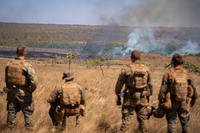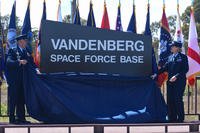SCHRIEVER AIR FORCE BASE, Colo. -- The 3rd Space Operations Squadron celebrated the Defense Satellite Communications System B10 satellite's 20th anniversary on orbit Nov. 28. The anniversary held significant importance for the squadron and for the Air Force, in part because the satellite was designed to operate for only 10 years.
Launched from Cape Canaveral, Fla., Nov. 28, 1993, DSCS B-10 was designed to provide wideband military communications to U.S. Strategic Command users. Following the launch the satellite was positioned over the Indian Ocean and served in the active DSCS constellation for more than 18 years before transitioning to a test asset in 2012.
Though it was built with 1980s technology, B-10 has provided critical communications service to warfighters throughout various worldwide conflicts that occurred during the past two decades.
More recently, contractor and 3rd SOPS engineers managed to squeeze even more use from the aging vehicle.
Most test assets perform their duties from a super-synchronized orbit at least 314 km above the geostationary belt. B-10, however, occupies a slot in geosynchronous orbit above the United States.
"We wanted to hold it in place like an operational satellite so we could test how DSCS communications payloads respond to software patch updates," said 1st Lt. Alexander Fiore, the DSCS engineering chief. "The vehicle is located near a stable point considered a 'gravity well,' so we don't have to perform station keeping maneuvers."
Fiore said despite the fact that the vehicle is low on fuel, 3rd SOPS engineers and contractors expect it to remain a viable test asset in the geostationary belt for another two years thanks in part to its stable location.
"The B-10 vehicle allows our team to test various procedures out before we implement them on an operational asset. We have more patches to test, so it's going to continue to be valuable," Fiore said. "Once we've reached the fuel threshold, we'll send it into a super-synched orbit and determine its extended usefulness from there."
"Nov. 28 marks a historic day for the 3rd SOPS and the 50th Space Wing," said Lt. Col. Chadwick Igl, the 3rd SOPS commander. "DSCS B-10 has been providing critical space effects to the warfigher for the better part of two decades.
"In its present capacity as a geosynchronous test asset, we have been provided with a unique opportunity to gain feedback on software patches that are critical to the entire DSCS constellation to provide secure, reliable wideband communications to America's warfighters," he said. "I want to personally thank the men and women of 3rd SOPS, Lockheed Martin, and Aeropsace who acquired and operated this vehicle with pride and dedication throughout its 20 years on orbit."


























